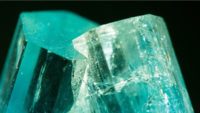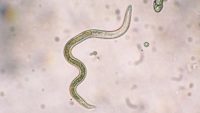By Ken Ham So many people today think of Neanderthals in the classic evolutionary sense—primitive brutes, grunting to communicate with one another and wielding clumsy stone tools. But that evolutionary depiction—still haunting the general public—is far from the reality that further investigation has uncovered. Ongoing research actually reveals what creationists have predicted: starting with the Bible, we know Neanderthals were humans, like us, from the beginning. In just the last decade or so, we’ve reported on findings that Neanderthal people made bone instruments, wore jewelry and makeup, heated and organized their homes, had children with modern man, dove for clams [More]
Secular scientists are finding exactly what Flood geologists have predicted all along—huge crystals can and did grow extremely fast. In other words, magmas can cool into minerals in a matter of days! Geology students are taught that large-crystal igneous rocks called pegmatites1 take vast amounts of time, even millions of years, to solidify and cool. Secular geologists reason that the minerals nee… More… …read more Source: icr.org
By Dr. Joe Francis The abundance of cellular diversity is better explained by biblical creation than evolutionary theory. …read more Source: AIG Daily
Creationists have written the most sophisticated evolutionary modelling program to date. Mendel’s Accountant is the final nail in neo-Darwinian neutral theory coffin. …read more Source: creation.com
By Dr. Andrew A. Snelling Evidence of rapid gem formation in California clashes with the old earth model but supports the biblical timescale and a young earth. …read more Source: AIG Daily
How a catastrophic event helped form an astonishing feature in Georgia’s landscape. …read more Source: creation.com
Göbekli Tepe is one of the world’s oldest architectural sites and is associated with early biblical history. It reveals further secrets demonstrating the mathematical and engineering knowledge of post-Flood man. …read more Source: creation.com
An exoplanet 260 light-years away is being described as the first of its kind ever detected.1,2 This exoplanet, catalogued as LTT 9779b, is called an “ultra-hot Neptune” because of its large size and nearness to its host star. This exoplanet is so close that its surface temperature is over 1700° Celsius, and the length of its year—the time it takes to orbit its star—is just 19 hours! Astronomers think the pl… More… …read more Source: icr.org
By Dr. Andrew Fabich Many accuse GMOs of being unhealthy foods that should not be sold without warning labels. In reality, the real problem is not usually the GMO itself, but the actual food product. …read more Source: AIG Daily
By Ken Ham Back in 2019 I blogged about a new “dinosaur” discovery—a “non-avian theropod” with bat-like, membranous wings. In my blog then, I quoted paleontologist Dr. Gabriela Haynes, who studied the research paper and supplemental materials. Based on the actual documented evidence (and freed from underlying assumptions about evolution and millions of years), Dr. Haynes argued that this so-called “dinosaur” may have been a bird that may, or may not, have had “bat-like” wings. Well, this bird is in the news again. This time around, Ambopteryx longibrachium and another presumed membranous-winged creature, Yi qi (discovered in 2015), are making [More]
Why the elephant is losing its tusks (and it’s not evolution!) …read more Source: creation.com
By Frank Sherwin Our world is filled with the little monsters and these parasites can be pretty nasty. …read more Source: AIG Daily
A letter to the editor in Nature Geoscience notes that this year marks the 100-year anniversary of Milutin Milankovitch’s (Milankovi?’s) book explaining how slow changes in Earth’s orbital and astronomical motions could affect its climate.1 This book, entitled Mathematical Theory of Heat Phenomena Produced by Solar Radiation, laid the mathematical groundwork for what would become “one of the m… More… …read more Source: icr.org
Manta ray filter with ricochet separation inspires non-clogging biomimetics …read more Source: creation.com
If the geologic strata were deposited by a global Flood, why aren’t there pre-Flood tools and buildings in the fossil record? …read more Source: creation.com
By Dr. Danny R. Faulkner Using a modified Boeing 747 equipped with infrared instruments, NASA discovered small amounts of water on the moon. What does that mean for biblical creation? …read more Source: AIG Daily
Well, there goes another star, disappearing into the night as if it had never existed. For an entire year, Hubble scientists used the space telescope to record snapshots of SN 2018gv—a supernova (SN) or exploded star. Experts then edited those images into a NASA video showing the fast fading of the supernova.1 It’s hard not to wonder, given the astronomical number of stars in the night sky, why we witness more stars fade th… More… …read more Source: icr.org
By Ken Ham In September headlines declared life had been discovered on Venus (which wasn’t even accurate to the actual contents of the study, but we’ll get to that later). Since then, articles regarding the search for alien life have listed hints of life on Venus as another exciting possibility in the continuing (very expensive) search for ET. Well, that was September. Now it’s October, and turns out . . . life wasn’t found on Venus after all. Hints (or signatures) of life weren’t even found on Venus. Here’s a summary of the first study I provided in my blog [More]
Today’s secular mindset replaces “In the beginning God…” with “In the beginning, hydrogen….” The extreme specificity of life’s chemical building blocks—let alone the innumerable, precise ways those chemicals combine to form living cells—demands a divine engineer. What natural processes ever generate even the most basic chemicals that go into living cells? Unfazed by such facts, origin-… More… …read more Source: icr.org
By Heather Brinson Bruce We’ve all heard about “the five senses”—sight, taste, touch, smell, and hearing. But are there other ways to experience the world? …read more Source: AIG Daily
We answer questions about post-Flood human and animal genetics. …read more Source: creation.com
Commemorating an idea that did not work …read more Source: creation.com
By Dr. Danny R. Faulkner Astronomers have attempted to identify exoplanets likely to support life though their efforts have generated scant results so far. …read more Source: AIG Daily
What should we think about phosphine in Venus’s clouds? Why do all living creatures use phosphate? …read more Source:
Shaun Doyle talks to Tim Clarey about his research career in Flood geology. …read more Source: creation.com
The standard theme often given for Viking history is that of blond-haired, blued-eyed, burly men exploring, trading, ransacking, and pillaging across Europe, Asia, and the North Atlantic. While historical Viking exploits still entertain history buffs, a pervasive study of DNA extracted from the bones of their burial sites is overturning the idea that a fair Scandinavian complexion was the norm among these people.1 The ac… More… …read more Source: icr.org
By Dr. Gordon Wilson Scorpions appear armed to scare and kill. Are we supposed to be afraid, or is it just our imagination? …read more Source: AIG Daily













































